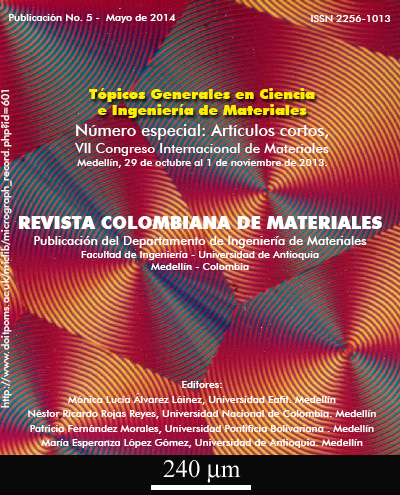.
DOI:
https://doi.org/10.17533/udea.rcm.19423Keywords:
Heat treatment, Wood, Dimentional stability, LigninAbstract
Downloads
References
Rowell, R.M, Ibach, E.R, McSweeny, J, Nilsson, T. “Understanding decay resistance, dimensional stability and strength changes in heat treated and acetylated wood”. Wood Mater SciEng, 1(2):14–22, 2009.
Stamm, A.J, Beachler, R.H. “Decay resistance and dimensional stability of five modified woods”. Forest Products Journal, 10:22–6, 1946.
Burmester, V.A. “Effect of heat-pressure treatments of semi-drywood on its dimensional stability”. Holz RohWerkst, 31:237–43, 1973.
Patzelt, M, Stingl, R, Teischinger, A. “Termische modifikation”. Lignovision en Band, :101e 49, 1681-2808, 2002.
Alen, R, Kotilainen, R, Zaman A. 1. “Thermochemical behaviour of Norway spruce (Picea abies)” . Wood Science and Technology,36:163 e71, 2002.
Yildiz S. “Physical, mechanical, technological and chemical properties of beech and spruce wood treated by heating”. PhD dissertation, KaradenizTechnical University, Trabzon, Turkey, 2002.
SyrjanenT, Oy, K. “Production and classification of heat treated wood in Finland”. Review on heat treatments of wood. In: Proceedings of the special seminar held in Antibes, France, 2001.
Mitchell, P.H. “Irreversible property changes of small loblolly pine specimens heated in air, nitrogen or oxygen”. Wood and Fiber Science, 20(3):320–55, 1988.
Ja ̈msa ̈ S, Viitaniemi, P. “Heat treatment of wood better durability without chemicals”. In: Rapp AO., editor. Review on heat treatments of wood. Costaction E22. Proceedings of the special seminar, Antibes, France, p. 17–22, 2001.
Stamm, A.J, Hansen, L.A. “Minimizing wood shrinkage and swelling: effect of heating in various gases”. Industrial and Engineering Chemistry Fundamentals, 29(7):831–3, 1937.
TiemannH.D. “Effect of different methods of drying on the strength and hygroscopicity of wood”. 3rd ed. Philadelphia, PA: J.P. Lippincott Co.; 1920 The Kiln Drying of Lumber [Chapter 11].
Fengel D, “On the changes of the wood and its components within the temperature range up to 200°C: thermally and mechanically caused structural changes in Sprucewood”. Vol. 24, no. 11. HolzRoh-u., Werkstoff, p. 529–36, 1966.
ASTM D4442–07 Standard Test Methods for Direct Moisture Content Measurement of Wood and Wood-Base Materials.
ASTM D1037–12 Standard Test Methods for Evaluating Properties of Wood-Base Fiber and Particle Panel Materials.
ASTM D143–09 Standard Test Methods for Small clear specimens of timber.








